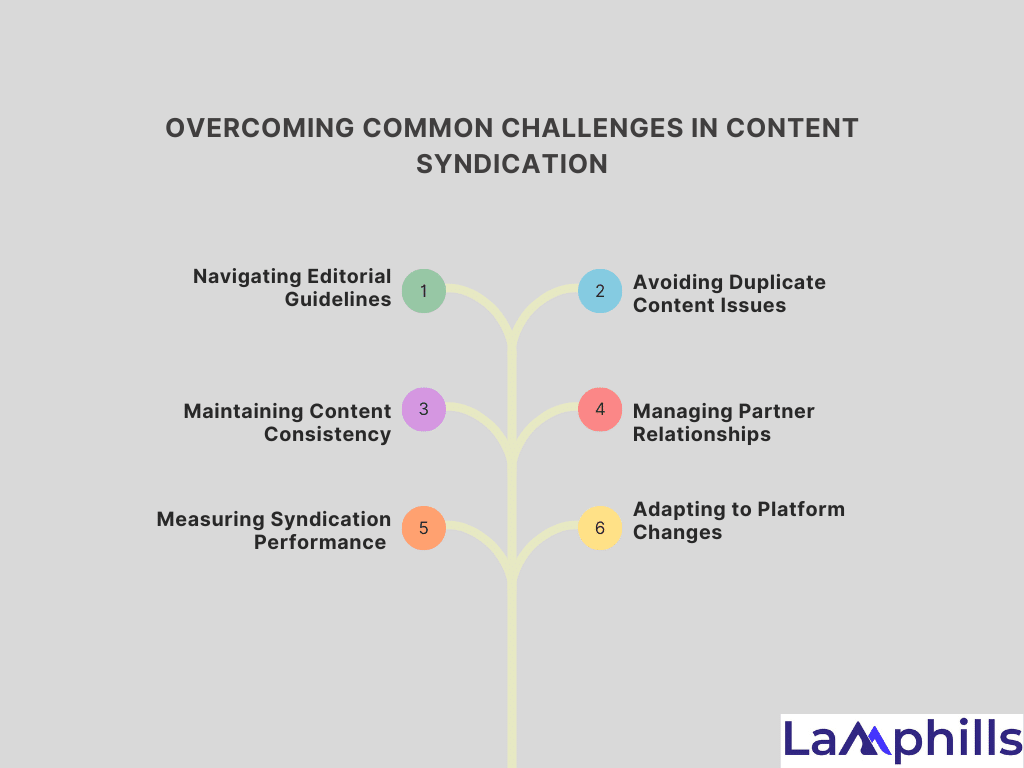As a seasoned marketer with years of experience navigating the digital landscape, I’ve witnessed firsthand the extraordinary potential of content syndication. Imagine you operate a business and enjoy sharing your expertise with the rest of the world. You’ve spent countless hours developing engaging content that showcases your knowledge and resonates with your target audience. However, despite your best efforts, your content remains hidden in the depths of your website, waiting to be discovered by the public.
This is when content syndication comes into play. It’s not just about spreading your message far and wide; it’s about strategically utilizing relationships and distribution channels to increase your reach and make a lasting impact. As a result, In this comprehensive guide, I’ll take you on a journey through the world of content syndication, from understanding its fundamental principles to implementing a successful strategy that drives results.
Key Takeaways
- Content syndication is the process of publishing again the same piece of material (such as an article, video, or infographic) on one or more distinct websites.
- Syndicating content is popular among publications of all sizes since it allows them to provide their viewers with current information.
- It’s necessary to understand that content syndication and guest blogging are not the same. While they appear to be comparable, a guest post is a wholly original piece of material created particularly for one publisher. Content Syndication refers to republishing the same piece of content on other platforms with permission.
- Focus on content that is timeless, high-quality, and relevant to your target audience. Select themes that address common pain points, answer commonly asked questions, or provide unique insights that appeal to your audience across several platforms and channels..
- To address editorial guideline issuess, check each syndication partner’s editorial rules and customize your material accordingly. Make sure to follow any directions and tailor your content to the partner’s preferences while retaining your brand voice and messaging.
What is Content Syndication

Content syndication is the process of publishing again the same piece of material (such as an article, video, or infographic) on one or more distinct websites. Syndicating content is popular among publications of all sizes since it allows them to provide their viewers with current information. This method also benefits the original authors by introducing their brand to a new audience. In the end, it is a win-win situation.
Understanding Content Syndication
It’s necessary to understand that content syndication and guest blogging are not the same, while they appear to be comparable. A guest post is a wholly original piece of material created particularly for one publisher. Syndicated material refers to republishing the same piece of content on other platforms with permission.
From the reader’s standpoint, an article that was syndicated rather than a guest post can be identified because the source is usually mentioned on the page. Hence, typically mark syndicated items with language like this:
“This article originally appeared in [Original publication + Link].”
OR
“This article appeared in [Original publication + Link] and has been published here with permission.”
At its simplest, content syndication is about spreading your work to a larger audience via numerous platforms and channels. It’s like casting a wide net across the huge ocean of the internet to ensure that your message reaches as many potential clients as possible.
However, content syndication is more than just broadcasting your material; it is also about developing relationships with reliable partners that can assist spread your message. Whether you’re working with industry influencers or established magazines, the goal is to select partners who share your brand values and can help you reach your intended market efficiently.
How Does Content Syndication Work?
There are multiple steps to syndicating your content like,
#1. Republish your latest or best-performing content on bigger websites, with more readers and higher authority than yours.
When you syndicate to a larger publication, you increase your reach. However, because readers may read the complete piece of material straight on the third-party website, there is little reason for them to visit the source. As a result, just a small fraction of readers will visit your site. That said, if your primary goal is to raise brand awareness, syndicating in large magazines is the way to go.
#2. Syndicate old content on websites that have roughly the same audience and authority as yours.
If you want to target a certain audience, consider syndicating your material to smaller, more concentrated magazines. Ideally, look for sources with comparable authority and readership to your blog. They may also enable additional contextual links, so you can link back to your blog from the article. It’s an excellent method to introduce their followers to more content on your site and generate new leads.
#3. Guest post on a bigger publication and syndicate later on your website, like Medium, or LinkedIn.
It is sometimes worthwhile to publish on a large site initially, as they may only be interested in new, original information. You benefit from putting your thought leadership in front of a large audience who might not have seen your content otherwise. After a while, depending on the publication, you can repost that content to your audience and social channels. You gain more value for your content investment.
#4. Get picked up by websites that naturally syndicate content
If you type the headline of a recent piece from a major newspaper into Google, you will notice that it has been picked up by several smaller publications. These usually feature an excerpt from the original piece with a link back to the source. To increase the visibility of your blog, start by developing a page that explains how others can syndicate your content. UniverseToday.com’s “steal our content…please” page serves as a nice example. Then, make sure your website is optimized for syndication.
Benefits of Content Syndication

Content syndication offers many advantages for businesses looking to expand their online presence and engage with their target audience effectively. Let’s explore these benefits in detail:
#1. Expanded Audience Reach
One of the key advantages of content syndication is the potential to spread your message and reach a larger audience. This is achieved by sharing your content across many platforms and channels, you can reach new audiences and attract users who would not have found your brand otherwise. In turn, it increases reach and boosts brand visibility and awareness, allowing you to connect with potential clients at all stages of the buying process.
#2: Improved SEO
Content syndication can significantly benefit your search engine optimization (SEO) efforts. When your content gets published on credible websites and platforms, it produces valuable backlinks to your site, indicating to search engines such as Google that it is authoritative and trustworthy. As a result, your website’s search engine rankings may improve, driving organic traffic and increasing your visibility in search engine results pages (SERPs).
#3. Enhanced Brand Authority
Publishing content on third-party platforms and industry magazines can help you promote your brand as a credible authority in your sector. When people find your material in reputable magazines, they are more inclined to regard your brand as credible and competent. Over time, this can lead to increased brand loyalty and trust, as well as improved industry awareness.
#4. Increased Website Traffic
As your content becomes more visible through syndication, consumers return to your website, increasing traffic to your digital enterprises. Whether through direct referrals from syndicated articles or organic search traffic from stronger SEO results, content syndication can help boost total website traffic and engagement. By providing valuable content that addresses the needs and interests of your audience, you can encourage visitors to explore your site further and engage with your brand on a deeper level.
#5. Lead Generation
Content syndication can also be a useful lead-creation strategy for businesses. Syndicated content allows you to reach a bigger audience, stimulate potential customers’ curiosity, and guide them through the sales process. You may encourage readers to take the next step and interact with your brand directly by providing gated content that requires user registration or embedding compelling calls-to-action (CTAs) in your syndicated articles.
#6. Cost-Effectiveness
Compared to typical advertising and marketing methods, content syndication is a low-cost option for promoting your brand and generating leads. Instead of investing heavily in paid advertising campaigns or outbound marketing tactics, you can leverage the reach and audience of existing platforms and publications. Deliver your material to a specific audience. This can result in a higher return on investment (ROI) and lower customer acquisition costs over time.
Strategies for Successful Content Syndication
Content syndication is a powerful marketing tactic, but success doesn’t happen by chance. Here are some key strategies to ensure your content syndication efforts are effective:
#1. Selecting Relevant Content

Not all content is acceptable for syndication. So, focus on content that is timeless, high-quality, and relevant to your target audience. Select themes that address common pain points, answer commonly asked questions, or provide unique insights that appeal to your audience across several platforms and channels. Before you publish, focus on the content:
- Quality
- Depth
- Relevance
- Authority
Then Aak yourself, “What is my content syndication strategy?” and ensure that your content:
- Fulfills the requirements of the syndication platforms
- It stands out on those websites
- Serves your goals
#2. Customizing Content for Different Platforms

Each platform has its unique audience, tone, and style. To do this, tailor your content to fit the preferences and expectations of each platform you syndicate to. This may involve adapting your headlines, formatting, and messaging to align with the platform’s audience and editorial guidelines. In addition to that, use canonical tags because Google recommends using canonical tags to signal which version of a syndicated page should be displayed in search engine results.
#3. Building Relationships with Syndication Partners

Create strategic alliances with media, influencers, and industry experts to help spread your content. Develop relationships with these partners by engaging with their material, providing value, and showing genuine interest in their audience and goals. This is because building rapport and trust is critical for forming long-term partnerships that benefit both sides.
#4. Finding Syndication Opportunities
Keep a look out for syndication opportunities on industry-specific platforms and publications. Look for websites, blogs, newsletters, and social media platforms that cater to your target demographic and allow guest posts or content submissions. To ensure congruence with your aims, conduct research on potential syndication partners and evaluate their audience, reach, and engagement data.
#5. Optimizing Content for Search Engines

Include SEO best practices in your syndicated material to increase its visibility and effect. Also, use relevant keywords, meta tags, and descriptive titles to optimize your content for search engines and increase its chances of appearing higher in search results. Then include internal and external links to relevant pages and resources to increase the SEO value of your syndicated material.
#6. Evaluating and Analyzing Performance

Monitor critical data and analytics to determine the effectiveness of your syndication activities. To determine the efficacy of your syndicated material, track metrics such as website traffic, engagement, conversion rates, and referral sources. Use this information to discover areas for improvement, fine-tune your syndication approach, and optimize future content syndication initiatives for greater success. You need to evaluate and optimize your syndicated content to generate high-quality leads. To understand lead quality, pay attention to:
- Engagement rate: The number of leads your sales executives can connect or engage with.
- Qualification rate: The leads that met the lead qualification criteria.
- Conversion rate: The speed at which qualified prospects convert across the sales pipeline.
- Win rate: The count of opportunities that convert to customers.
But there are certain secondary factors involved too. Brand lift and traffic can also indicate campaign success, even if it’s not easy to identify ROI for those outcomes.
#7. Maintaining Consistency and Quality
Consistency is essential for increasing brand reputation and trust with your audience. Maintain a regular publishing schedule and high-quality requirements for all syndicated content. Ensure that your material is well-written, educational, and interesting and that it enhances your brand’s reputation. Consistent, high-quality content will keep your audience coming back for more, while also strengthening your brand’s presence across several platforms and channels.
Implementing a Content Syndication Strategy
Creating a content syndication strategy needs meticulous preparation, implementation, and oversight. Here’s a thorough overview of the stages involved:
#1. Establishing Clear Goals and Objectives
Define your content syndication goals and objectives first. What do you hope to accomplish? Whether it’s raising brand awareness, driving website traffic, creating leads, or increasing sales, specify your goals to drive your syndication efforts.
#2. Identifying Target Audience
Recognize your target audience and where they are most active online. Identify the platforms, magazines, and communities where your target audience spends time and interacts with material about your industry or niche.
#3. Selecting Syndication Partners
Research and find suitable syndication partners who have access to your target audience and share your brand’s values. Look for journalists, influencers, industry leaders, and content aggregators that welcome guest posts or content submissions related to your topic.
#4. Create Syndicated Content
Create high-quality, interesting material designed exclusively for syndication. Make sure your material is well-written, informative, and offers value to the reader. Customize your material to match the style, tone, and structure of each platform or publication you intend to syndicate to.
#5. Creating Syndication Agreements
Contact possible syndication partners and sign agreements or partnerships for content distribution. Clearly define the terms, rights, and duties involved with syndicating your content, such as attribution, exclusivity, and editorial standards.
#6. Implementing Distribution Channels
Distribute your syndicated content through the agreed-upon platforms and channels utilizing a variety of distribution strategies. This could include submitting guest posts, writing articles for industry magazines, distributing content on social media platforms, or collaborating with content syndication networks.
#7 Measuring Performance and Analytics
Using analytics tools and metrics, you may monitor and track the performance of your syndicated material. To analyze the efficiency of your syndication efforts, track key performance indicators (KPIs) such as website traffic, engagement, conversion rates, and referral sources.
#8. Optimization and Iteration
Use performance metrics data and insights to continuously enhance and refine your syndication strategy. Determine what works well and what needs to be improved, and then make data-driven decisions to optimize future syndication efforts for greater outcomes.
#9. Maintaining Relationships and Communication
Maintain open communication, provide value, and honor any agreements or promises with syndication partners to foster positive relationships. Engage with partners regularly, respond to feedback, and work on future content opportunities to develop collaborations and optimize mutual value.
#10. Ensure Consistency and Compliance
Maintain consistency in your syndication efforts by sticking to publication schedules, quality standards, and editorial rules. Ensure that syndicated content adheres to copyright laws, attribution standards, and any contractual agreements or syndication policies established with partners.
Overcoming Common Challenges in Content Syndication

Content syndication can present various challenges that marketers need to navigate to ensure the success of their efforts. Let’s explore these challenges and how to overcome them:
#1. Navigating Editorial Guidelines
Many syndication partners have strict editing criteria and restrictions for content submission. These rules may include word count restrictions, formatting preferences, or editorial tone requirements. To address this difficulty, check each syndication partner’s editorial rules and customize your material accordingly. So, make sure to follow any directions and tailor your content to the partner’s preferences while retaining your brand voice and messaging.
#2. Avoiding Duplicate Content Issues
Syndicating information across different platforms raises worries about duplicate content, which can have a detrimental influence on search engine rankings. To address this issue, utilize canonical tags or describe the source of the material to ensure correct attribution and prevent duplicate content fines. Consider producing unique variations of your material for syndication, such as changing the headline or adding new insights or commentary to set it apart from the original edition.
#3. Maintaining Content Consistency
Consistency is essential for increasing brand reputation and trust with your audience. However, syndicating material across several channels can make it difficult to maintain consistency in messaging, branding, and tone. To handle this, create a defined content strategy and style guide that defines your brand voice, message guidelines, and visual identity. Ensure that all syndicated content follows these criteria to ensure consistency and promote your brand’s image across all media.
#4. Managing Partner Relationships
Building and maintaining relationships with syndication partners takes time, effort, and clear communication. However, maintaining several relationships can be difficult, particularly when it comes to coordinating material submissions, approvals, and publication dates. To tackle this, create open lines of communication with your syndication partners and maintain regular touch to ensure alignment and collaboration. So, keep partners informed of any modifications or changes to your content strategy, and respond to their feedback and requests to create productive relationships and mutual trust.
#5. Measuring Syndication Performance
Measuring syndicated content success can be difficult due to variances in monitoring mechanisms, analytics tools, and attribution schemes between platforms. To address this issue, establish a sophisticated tracking and analytics system that allows you to track critical data such as website traffic, engagement, conversion rates, and referral sources for syndicated material. Tracking parameters, UTM tags, or unique landing pages can help you precisely attribute traffic and conversions to syndicated content and evaluate its influence on your marketing objectives.
#6. Adapting to Platform Changes
The digital landscape is continuously changing, with platforms often upgrading their algorithms, policies, and features. Changes in platform algorithms or policies can have an impact on the visibility, distribution, or performance of syndicated content, making content syndication initiatives more challenging. To address this difficulty, stay current on platform updates and changes that may affect your syndication strategy. Prepare to alter your approach, techniques, or content formats to line with platform requirements and enhance the efficacy of your syndication efforts when platform dynamics change.
How is content syndication different from guest posting?
Content syndication is a way to republish your content. Guest posting, on the other hand, means that you publish original content on third-party sites.
Is content syndication worth it?
Content syndication is a powerful solution that can help you expand your reach without investing a ton of additional man-hours.
How much does content syndication cost?
The cost of content syndication also varies according to the specific services or pricing models offered but ranges from $0.4 to $3.
How to calculate content syndication ROI?
Use Average Contract Value (or Average Deal Size) to calculate a rough estimate of your potential revenue from a content syndication campaign. Together, these basic numbers give you a rough calculation of your % return potential with content syndication where ROI = (return – spend)/spend.
Conclusion
As we conclude, I encourage you to embrace the power of content syndication—a strategy that holds the key to unlocking your material’s true potential. Going off the beaten path and digging into the complexities of syndication can help you develop your brand, expand your reach, and form long-term relationships with your audience.
Finally, remember that success in content syndication is decided by the narrative you share, the relationships you build, and the impact you have on your audience’s lives, not by data and analytics. So, armed with the knowledge and insights obtained from this guide, go into the digital world with confidence and let your voice be heard far and wide.
References
- demandscience.com
- blog.hubspot.com
- learn.g2.com
- indeed.com






